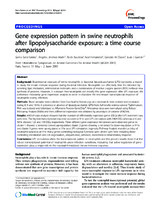Mostrar el registro sencillo del ítem
Gene expression pattern in swine neutrophils after lipopolysaccharide exposure: a time course comparison
| dc.contributor.author | Sanz-Santos, Gema | |
| dc.contributor.author | Jiménez-Marín, Ángeles | |
| dc.contributor.author | Bautista, Rocío | |
| dc.contributor.author | Fernández, Noé | |
| dc.contributor.author | Claros, Gonzalo M. | |
| dc.contributor.author | Garrido, Juan J. | |
| dc.date.accessioned | 2013-10-16T12:09:31Z | |
| dc.date.available | 2013-10-16T12:09:31Z | |
| dc.date.issued | 2011 | |
| dc.identifier.uri | http://hdl.handle.net/10396/11132 | |
| dc.description.abstract | Background: Experimental exposure of swine neutrophils to bacterial lipopolysaccharide (LPS) represents a model to study the innate immune response during bacterial infection. Neutrophils can effectively limit the infection by secreting lipid mediators, antimicrobial molecules and a combination of reactive oxygen species (ROS) without new synthesis of proteins. However, it is known that neutrophils can modify the gene expression after LPS exposure. We performed microarray gene expression analysis in order to elucidate the less known transcriptional response of neutrophils during infection. Methods: Blood samples were collected from four healthy Iberian pigs and neutrophils were isolated and incubated during 6, 9 and 18 hrs in presence or absence of lipopolysaccharide (LPS) from Salmonella enterica serovar Typhimurium. RNA was isolated and hybridized to Affymetrix Porcine GeneChip®. Microarray data were normalized using Robust Microarray Analysis (RMA) and then, differential expression was obtained by an analysis of variance (ANOVA). Results: ANOVA data analysis showed that the number of differentially expressed genes (DEG) after LPS treatment vary with time. The highest transcriptional response occurred at 9 hr post LPS stimulation with 1494 DEG whereas at 6 and 18 hr showed 125 and 108 DEG, respectively. Three different gene expression tendencies were observed: genes in cluster 1 showed a tendency toward up-regulation; cluster 2 genes showing a tendency for down-regulation at 9 hr; and cluster 3 genes were up-regulated at 9 hr post LPS stimulation. Ingenuity Pathway Analysis revealed a delay of neutrophil apoptosis at 9 hr. Many genes controlling biological functions were altered with time including those controlling metabolism and cell organization, ubiquitination, adhesion, movement or inflammatory response. Conclusions: LPS stimulation alters the transcriptional pattern in neutrophils and the present results show that the robust transcriptional potential of neutrophils under infection conditions, indicating that active regulation of gene expression plays a major role in the neutrophil-mediated- innate immune response | es_ES |
| dc.format.mimetype | application/pdf | es_ES |
| dc.language.iso | eng | es_ES |
| dc.publisher | BioMed Central | es_ES |
| dc.rights | https://creativecommons.org/licenses/by-nc-nd/4.0/ | es_ES |
| dc.source | BMC Proceedings 5 (Suppl 4) (2011) | es_ES |
| dc.subject | Innate immune response | es_ES |
| dc.subject | Bacterial infection | es_ES |
| dc.subject | Swine | es_ES |
| dc.title | Gene expression pattern in swine neutrophils after lipopolysaccharide exposure: a time course comparison | es_ES |
| dc.type | info:eu-repo/semantics/article | es_ES |
| dc.rights.accessRights | info:eu-repo/semantics/openAccess | es_ES |

